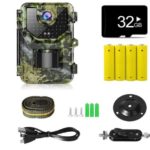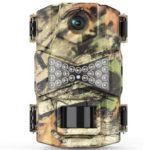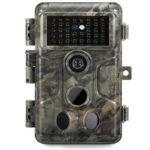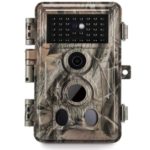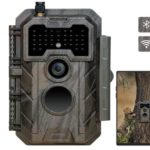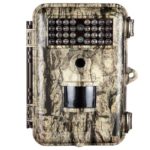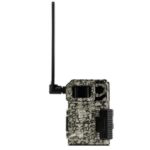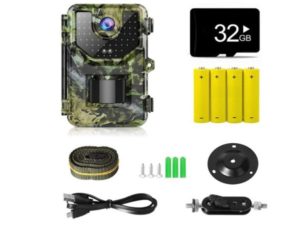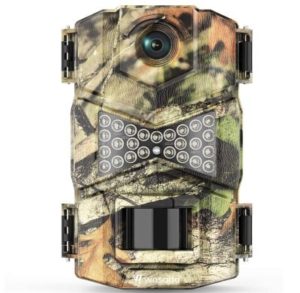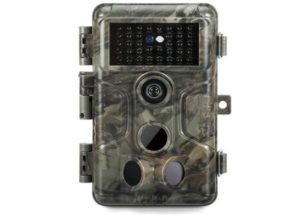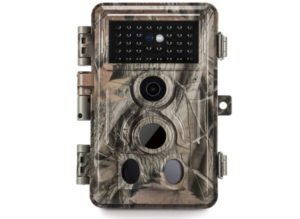Trail cameras, nature cameras, game cameras, or remote cameras, whichever name you choose to refer to them, there is no denying the benefits one could harness from these devices. In this post, we comprehensively cover the best trail camera for night pictures.
With the current advancement in technology, these cams can capture photos, videos and others can do both depending on the configuration whether it’s day or night.
Hunters can narrow in on their target through observation of the area where they live while wildlife enthusiasts get to capture and gather curated photos or videos of the game in their natural habitat. Through heat or motion sensors, trail cameras are triggered to begin taking shots of animals that come wandering in the area they are set up.
The best trail cameras can be so efficient that some people are often tempted to use them as security cameras in their homes as they do well in capturing human activity as they do wildlife.
With this is in mind, let’s browse through some of the best trail cameras today.
Best Trail Camera for Night Pictures-Our Top Picks
| Trail Camera | Key Highlights |
| Vikeri A1 Trail Camera
|
Best Price |
| WOSODA Trail Camera
|
|
| GardePro A3 Trail Camera
|
|
| Meidase P40 Trail Camera
|
|
| GardePro E7 WiFi Trail Camera
|
|
| Bushnell Trophy Trail Camera
|
|
| SPYPOINT LINK-MICRO-LTE-V Cellular Trail Camera
|
|
Do Trail Cameras Take Color Pictures at Night?
Trail cameras take crystal clear colorful images during the day and clear black and white images at night using no glow infrared flash.
How Do Trail Cameras Take Pictures at Night?
Trail Cameras take pictures using no glow infrared night vision and blur reduction technology for clear night vision
Does a Trail Camera Flash at Night?
Trail cameras flash a white light when triggered at night. The flash illuminates the image.
Now let’s look at each trail camera comprehensively.
Vikeri A1 Trail Camera
Vikeri A1 Trail Camera tops our Best trail camera for night pictures list. For night vision you get an advanced Super Infrared Night Vision. The 940nm 48 IR LED night vision with no glow is perfect for night pictures and videos. You can use this Trail camera for Hunting, Home security, Wildlife Monitoring, and Farm Monitoring. With a 180days Standby Time and Ultra-High Concealment, the camera blends well with nature making it undiscoverable by wildlife or humans. The camera is easy to use and set up. It comes with a mounting strap for easy installation and stability. With Ultra High Video Video Resolution the camera delivers stunning images even in darkness. The audio is also clear to make sure you miss nothing on the trail. The camera is also dust, rain, and drop proof making it a perfect fit even for the harshest environments. Its also made of high-grade IP66 materials for durability. In the Package:Vikeri A1 Trail Camera, 4x Alkaline battery, a 32GB SD card, Micro USB Cable, User Manual, Installation Belt, Stand Mount & Stand Support, and 3x Bolts & Stoppers Features
|
WOSODA Trail Camera
WOSODA Waterproof 16MP 1080P Trail Camera has an incredible trigger speed capturing images in less than a second which makes sure you will not miss out on any daylight or nighttime wildlife action. Sensitivity is covered for any movement within 65ft. Images are captured at a 16MP resolution and videos are at a fine 1080 full HD resolution. 25Pcs 850nm Infrared low-glow black LEDs capture quality videos or photos during the night. The WOSODA trail camera has a waterproof housing and runs on battery power. The camera has a 65ft flash range in the dark. Mounting straps are part of the package for easy installation at whatever point you choose. A versatile configuration like multi-recording modes and additional features like the timer and time switch, enhance monitoring of specific wildlife behavior or characteristic. Features
|
GardePro A3 Trail Camera
Check Price on Amazon
Should you be keen on observing nocturnal wildlife GardePro A3 Trail Camera 20MP 1080P H.264 Video Game Camera is the best trail cam to grab. This trail camera can pick movement in low light conditions and still make blur-free photos and videos from it. This is enabled by the camera’s 100ft night vision flash range. Video footages recorded on this camera have a 1080P resolution alongside sound and are in MP4 format compatible with most players. The lightning trigger speed of 0.1seconds ensures slight movements within 82ft are not missed. The tech used in designing this camera’s aperture ensures blur reduction for clarity even for images captured in poor lighting conditions. This battery-powered trail camera has a 2.31-inch color display and can support up to 128GB SD card. Apart from loop recording, long stand-by periods, and programming of operating hours, this trail camera comes with a year’s manufacturer’s warranty. Key Highlights
|
Meidase P40 Trail Camera
Check Price on Amazon
From a fervent howl of foxes to the elk bugle, trail cameras with sound recording capabilities are a plus. If hearing animal sounds is what you want as part of the package then the Meidase Trail Camera is your ideal choice. With this trail camera, you get 24MP crystal clear images. With an advanced image sensor and firmware, you won’t miss all the fantastic images even at night. This trail camera is fitted with a highly sensitive microphone for clear sound recording. On it are state-of-the-art image sensors with a 0.2s trigger speed. They can get triggered by objects moving within 82ft of their 120°angle coverage distance. The friendly user interface also makes programming a cinch. Best trail cameras are built to last which is why you will marvel at the waterproof construct of this cam. Features
|
See Also: 8 Best Campark Trail Cameras
How Do I Choose a Trail Camera?
How to Choose the Best Trail Camera for Night Pictures
Megapixels
One of the major specs to look out for are the megapixels that to a large extent determine whether or not you will get a fine detail image. The higher the megapixels, the more you are likely to get a quality image. Image quality is also closely related to the type of lens used on the camera. The bigger the focal length the more the area you can capture.
Shutter Speed
How fast can the camera capture the image? Fast detection and immediate image capture are what you want in a trail camera. Choice of slow detecting cameras will leave you blurred images or some parts of your intended target getting cropped out.
Built-in Flash Light
If you are set on observing nocturnal animals it would be wise to go for a trail camera with built-in flash preferably one made specifically for low light conditions and one that would pass unnoticed by the animal. Trail cameras with infrared built-in flash are a perfect choice for this purpose.
Construction
How and what is used to build the camera is a big determinant of its durability and efficiency in operation. Best trail cameras are made out of strong, waterproof material with an earth-like finish for camouflage to prevent easy detection by wildlife. A sturdily built camera can weather rain, snowfall, and extreme temperatures. Some cameras also have solar power features to reduce the need for constant battery change.
Detection Range
The detection range determines how far out an object should be for its movement to trigger the activation of the camera. The average distance for majority trail cameras falls at about 65 feet but high-end models could detect objects at a further distance than that.
Wireless Features
Most trail cameras will require you to physically get to their location for retrieval of photos or videos but in the market currently, brands are giving the wireless option, where you can even change the settings on the camera using your mobile phone at the comfort of any location provided that network connection is fully functional.
Tips on How to Use Trail Cameras
- Check the Camera Setting>Test your camera to ensure it’s on the right settings in terms of resolution, sensitivity, and away from exposure to false triggers. Remember to check batteries and SD cards.
- Trails> Choice of the trail is important because some areas may leave you very little of what should be mounting surfaces to set up your camera. You need a steady strong mounting safe away from obstructions but also that can camouflage the trail camera properly.
- Enough Trail Cameras>Sometimes one trail camera will not suffice and you may be required to set up several to properly monitor your target.
- Security>For safety from trespassers or curious individuals going through the woods, you may need to consider purchasing a lockbox or a trail camera with GPS installation.
Best Trail Cameras FAQs
Q: What is the Difference Between Cellular and Wireless Trail Cameras?
A: Simply put, wireless trail cameras require wi-fi signals or radio frequencies to transmit images and videos while cellular trail cameras require cell towers for connection to transmit. The advantage cellular trail cameras have over wireless ones is the increased range from the camera installation point.
Q: When Should You Set Up a Trail Camera?
A: Trail cameras can be set up just before the hunting season but if your cam has long battery life like for up to 6months and over you can set up earlier to get valuable information on wildlife patterns. After hunting season, you can choose to retain, move or completely withdraw the camera.
Q: Where to Place Trail Cameras?
A: Some of the high traffic areas you can set up your trail cameras include but are not limited to the following:
- Food sources
- Water sources
- Trail intersections/crossroads
- Over bait
Conclusion
Investing in a good trail camera is a worthy venture if you are to enjoy the thrill of capturing pictures at night. If you are only interested in trail cameras for purposes other than hunting the above-reviewed trail cameras are multipurpose.
Our Best Trail Camera for Night Pictures collection has a piece for everyone, so go ahead and choose to your liking.
Read Also: Best Game Hunting Cameras


